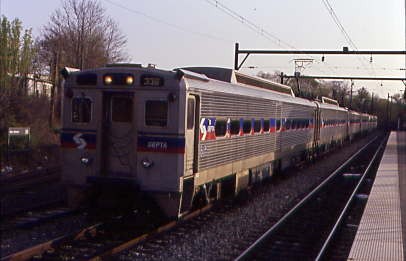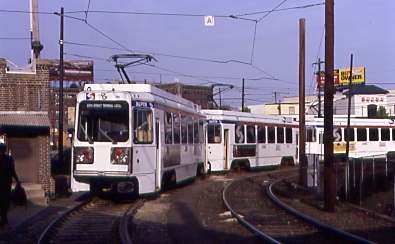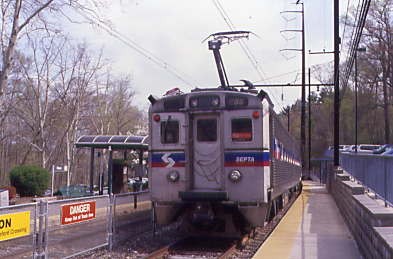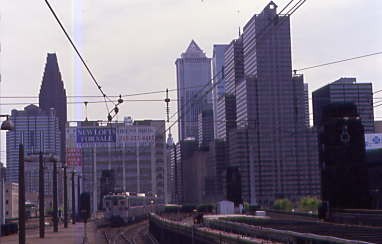SEPTA is a regional public transportation authority that operates bus, rapid transit, commuter rail, light rail and electric trolleybus services for nearly four million people throughout five counties in and around Philadelphia, Pennsylvania. It also manages projects that maintain, replace, and expand its infrastructure, facilities and vehicles.
SEPTA is the major transit provider for the city of Philadelphia and four surrounding counties within the Philadelphia metropolitan area: Delaware, Montgomery, Bucks and Chester. It was created by the Pennsylvania legislature on August 17, 1963, to coordinate government funding to various transit and railroad companies in southeastern Pennsylvania. It commenced on February 18, 1964. By 1966, the Reading Company and Pennsylvania Railroad commuter railroad lines were operated under contract to SEPTA. On February 1, 1968, the Pennsylvania Railroad merged with the New York Central railroad to become Penn Central, only to file for bankruptcy on June 21, 1970. Penn Central continued to operate in bankruptcy until 1976, when Conrail took over its assets along with those of several other bankrupt railroads, including the Reading Company. Conrail operated commuter services under contract to SEPTA until January 1, 1983, when SEPTA took over operations and acquired track, rolling stock, and other assets to form the Railroad Division.
On September 30, 1968, SEPTA acquired the Philadelphia Transportation Company, which operated a citywide system of bus, trolley, and trackless trolley routes, the Market–Frankford Line (subway-elevated rail), the Broad Street Line (subway), and the Delaware River Bridge Line (subway-elevated rail to City Hall, Camden, New Jersey) which became SEPTA's City Transit Division. The PTC had been created in 1940 with the merger of the Philadelphia Rapid Transit Company (formed in 1902), and a group of smaller, then-independent transit companies operating within the city and its environs.
On January 30, 1970, SEPTA acquired the Philadelphia Suburban Transportation Company, also known as the Red Arrow Lines, which included the Philadelphia and Western Railroad route now called the Norristown High Speed Line, the Media–Sharon Hill Line (Routes 101 and 102), and several suburban bus routes in Delaware County. Today, this is known as the Victory Division, though it is sometimes referred to as the Red Arrow Division.
On March 1, 1976, SEPTA acquired the transit operations of Schuylkill Valley Lines, known today as the Frontier Division. Meanwhile, SEPTA gradually began to take over the Pennsylvania Railroad and Reading Company commuter trains. SEPTA primarily sought to consolidate the formerly-competing services, leading to severe cutbacks in the mid-1980's. Subsequent proposals have since been made to restore service to Allentown, Bethlehem, West Chester and Newtown, with support from commuters, local officials, and pro-train advocates.
Broad Street Line
I left the Holiday Inn Express and walked two blocks to Broad Street, finding the stairway to the Broad Street subway, the north/south subway line in Philadelphia. I had no idea what the train would look like until one arrived then boarded a southbound train at the Walnut/Locust station which took me to Lombard-South, Ellsworth-Federal, Tasker-Morris, Snyder, Oregon and the last stop at Patterson.

I reboarded and retraced my steps but at Broad Street, stayed on the train, continuing north through City Hall, Pace-Vine/Convention Center, Spring Garden, Fairmount and Girard, Cecil B. Moore/Temple University, Susquehanna-Dauphin, North Philadelphia, Allegheny, Erie, Hunting Park, Wyoming, Logan, Olney and onto the Fern Rock Transportation Center. Here we made a loop around the shops before stopping at the station.


The train at Fern Rock. I reboarded the train and found a seat right behind and to the left of the operator, which not only gave a great view of the operations, but also an excellent view looking ahead. The tunnel walls had graffiti most of the way throughout the route and I returned to the City Hall Station where I transferred to the other subway line.

I went up some stairs and followed the signs, which took me directly to my next train.
Market-Frankford Line
My plan was to first go west to the 69th Street terminal, then back, going east to the Frankford Transportation Center. The train arrived and went past 30th Street, 34th Street and 40th Street before emerging onto the elevated tracks. It was night time as we passed 46th Street, 52nd Street, 56th Street, 60th Street, 63rd Street, Millbourne and the last stop at the 69th Street Terminal. After detraining, I used the overhead walkway, showing my transfer to go east to the Frankford Transportation Center.
I boarded car 1082, returning through all the stations to City Hall then entered more new trackage. We stopped at 13th Street, 11th Street, 8th Street, 5th Street and 2nd Street before leaving the underground and remained elevated for the rest of the way. The train went to Spring Garden, Girard, Berks, York-Dauphin, Huntingdon, Somerset, Allegheny, Tioga, Erie-Torresdale, Church, Margaret-Orthodox and finally the Frankford Transportation Center.

I rode car 1123 on the return trip to City Hall where I transferred to the Broad StreetLine for the one-stop ride to Walnut/Locust, where I returned to the Holiday Inn Express for the night.
4/17/2006 The next day, I walked to the Market Street SEPTA station, stopping at Dunkin' Donuts ono the way before finding the track for the R6 train. This is one of the two Philadelphia regional rail lines I had not yet ridden.
SEPTA Train 4616 R6 to Norristown Elm StreetI boarded Car 336 and at 6:36 AM, I was on my way. The first stop was Temple University, followed by North Broad. Under the Northeast Corridor, we turned onto new trackage before proceeding to Allegheny, East Falls, Wissahickon and Manayunk. The line ran up the valley then went under a former electric line, now a bicycle route. We then followed the Schuylkill River as we stopped at Ivy Ridge, Miquon, Spring Mill and Conshohocken, then onto the Norristown Transportation Center, where I would connect to Route 100 on the way back. The train then travelled to Main Street and came to the end of the line at the Norristown Elm Street station.

My train at Elm Street.

A SEPTA set ready to be put in service.

SEPTA 239.

My train switching on to the longer trainset.


SEPTA 336. I boarded SEPTA Train 6617 and we departed shortly thereafter. At Norristown Transportation Center, I paid the conductor the cash fare from Elm Street as I detrained, then walked over to the Route 100 station and went upstairs to a waiting train.



This is the first of the SEPTA high-speed trolley routes I would ride this morning. This trolley only stops if you press a button in the station or someone wants to get off. It is a fast and efficient form of transportation and was a pleasure to finally ride. We left at 7:42 AM and crossed high over the Schuylkill River, stopping at Bridgeport, King Manor, Hughes Park, Gulph Mills and Matsonford, followed by County Line. This part of the line is highly scenic. Before Radnor, we passed beneath the former Pennsylvania Railroad Harrisburg Line, also known as the SEPTA R5 Line.
We made our way southeast to Villanova, Stadium, Garrett Hill, Rosemont, Bryn Mawr, Haverford, Ardmore Avenue, Ardmore Junction, Wynnewood Road, Beechwood-Brookline, Penfield, West Overbrook, Parkview and then to 69th Street Terminal, the end of Route 100. I detrained and went looking for Route 102, the starting point for my next ride.

I boarded car 1061 and departed 69th Street Terminal, stopping at Fairfield Avenue, Walnut Street, Bywood, Hilltop Road, Beverly Hills, Congress Avenue, Lansdowne Avenue, Drexel Park and Irvington Road, before coming to Drexel Hill Junction. Routes 101 and 102 share all the stations up to this point. At Drexel Hills Junction, we went straight, turning left to Garrettford, Drexel Manor, Marshall Road, Oakview, Baltimore Pike, Penn Street, Springfield Road, Clifton Road (a connection with the SEPTA R3 Line), Shisler Avenue, Providence Road, Magnolia Avenue, North Street, Bartram Avenue, Andrews Avenue, Collingdale and finally Chesterfield/Sharon Hill.


SEPTA N-5 106 built by General Swedish Electrical Limited Company in 1993 at Sharon Hill. I reboarded for the trip back to Drexel Hill Junction.



My trolley at Drexel Hill Junction and then leaving.

A trolley from Media during my layover.


A outbound Sharon Hill train.


An inbound Media trolley.
SEPTA 101 Route
I boarded car 117 for Media and we passed through Drexel Hill Junction and proceeded to Huey Avenue, School Lane, Aronimink, Anderson Avenue Drexelbrook, Drexeline, Scenic Road and Springfield Road then continued on to Saxer Avenue, Leamy Avenue, Woodland Avenue, Thomson Avenue, Springfield Mall, Paper Mill Road and Pine Ridge. From there, the train passed through Beatty Road, Bowling Green, Manchester Avenue, Edgemont Street, Jackson Street, Olive Street, Veterans Square and Media, the final stop.

Car 117 sitting in the middle of State Street. I walked down Orange Street to find the SEPTA R3 Media station and after purchasing my ticket to Elwyn, went to a market for some snacks before waiting Train 331.

R3 Train 331 picked me up for the four-minute trip to Elwyn and on the way, we crossed high over Ridley Creek.
SEPTA 350 R3 Train to 30th Street
I boarded Car 170 and waited for departure time back to 30th Street Station.

The conductor sold me a ticket to get me all the way to Trenton. The Media-Elwyn Line was the final SEPTA Regional rail line I needed to ride. We crossed Ridley Creek and arrived at Media to pick up approximately twenty passengers and along the way, I noted that Moylan/Rose Valley had a post office in the station, Wallingford's was very unique, Swarthmore had a beautiful stone station and Morton had a brick one.
We stopped at Secane, Primos and Clifton Alder, where one connects with SEPTA Route 102, then crossed a high bridge over Darby Creek just before Lansdowne, with a familiar-looking Pennsylvania Railroad station sign on the building. Fernwood-Yeadon was just a platform, as was Angora. From here, we returned to the inner city of Philadelphia, complete with row houses. We stopped at 49th Street, then travelled on the Northeast Corridor to University City before arriving at 30th Street Station and I had now completed every regional rail mile of SEPTA.

A train bound for Chestnut Hill East.

That train on its way towards the downtown Philadelphia stations.

This train was travelling to Elwyn.
SEPTA Train 733 to Trenton, New Jersey
We departed the upper level of 30th Street station upper level platform, with me in car 349. Once past Zoo Tower, we entered the Northeast Corridor for the run to Trenton, stopping at North Philadelphia, Bridesburg, Tacony, Holmesburg, Torresdale, Cornwells Heights, Eddington, Croydon, Bristol and Levittown, before crossing the Delaware River into Trenton, New Jersey.

I detrained, walked into the station and picked up some River Line schedules for me and other Orange County Railway Historical Society members then exited the station and to my right was my next ride.
New Jersey Transit River LineThis route connects the cities of Camden and Trenton, New Jersey's capital, so-named because its route between the two cities is parallel to the Delaware River. The River Line was constructed on what originally was the Camden- Bordentown section and the Bordentown-Trenton Branch of the Camden & Amboy Railroad. The lines ran under the C&A name between 1830 and 1871, when the line was absorbed into the Pennsylvania Railroad. Ownership proceeded under Penn Central after 1968, and Conrail from 1976 to June 1, 1999, but the original passenger service had been abandoned in 1963.



After a trio of photographs, I bought my ticket for a trip on the region's newest light rail line, whose motive power is diesel, so there are no overhead wires. We departed at 1:00 PM, but stopped to change crews at the Trenton Shops. The engine shut down and after several attempts, including help from our previous operator, they managed to get it started. We stopped at Hamilton and Cass Street, then the line ran through some lowlands and forests; a very scenic line and I enjoyed the ride very much.
A curved bridge took us across the Crosswick Creek before Bordentown and then entered the joint freight line, which is used after the River Line shuts down for the night. We ran along the Delaware River then passed the first two sidings which were full of freight cars and stopped at Roebling, then passed the former Florence station, still standing, before stopped at Florence Park. Our train continued its sprint past a CSX freight train and the large US Pipe plant before turning into the median down the middle of Broad Street in Burlington, whose station now houses the local police.
We next stopped at Burlington South, then continued on to Beverly/Edgewater Park and Delanco before crossing Rancocas Creek and made our way to Riverside, where that station is now the Lourdes Thrift Depot.

The interior of our train at Cinnaminson. The journey continued to Riverton and minutes later, Palmyra Station before travelling over Pennsauken Creek and arriving at Route 73/Pennsauken station. We passed under the New Jersey Transit Atlantic City Line, had a great view of downtown Philadelphia before arriving at 36th Street station then passed the main River Line shops and the Norfolk Southern yard.

The engines in the yard. We entered Camden, New Jersey and stopped at the Walter Rand Transportation Center then continued on to Cooper Street/Rutgers University, Aquarium Station and the last stop at the Camden Entertainment Center, where I detrained.




New Jersey Transit River Line DMU 3918 built by Stadler Rail Group in partnership with Bombardier Transportation in 2004 and manufactured in Switzerland and Germany. What a fantastic job New Jersey Transit did when they built this unique light rail line. I waited twenty minutes for my trip back to the Rand Transportation Center and the connection with PATCO.

I went into the Center, bought my tickets and went downstairs.
Port Authority Transit CorporationThe PATCO Speedline, signed in Philadelphia as the Lindenwold Line and also known colloquially as the PATCO High Speed Line, is a rapid transit route operated by the Port Authority Transit Corporation, which runs between Philadelphia, Pennsylvania, and Camden County, New Jersey. The line runs underground in Philadelphia, crosses the Delaware River on the Benjamin Franklin Bridge, runs underground in Camden, then runs above ground to the east end of the line in Lindenwold, New Jersey (with the Haddonfield, New Jersey stop being below street level). The Port Authority Transit Corporation and the Speedline are owned and operated by the Delaware River Port Authority. The line opened between Lindenwold and Camden on January 4, 1969, with the full line to Philadelphia opening a few weeks later on February 15, 1969.
As with most of today and tomorrow's train rides, this would be another first for me.

I rode the first train out to Lindenwold, with details below.

Meeting a westbound train after it had passed.

My eastbound train before it went out-of-service.

My 3:11 PM westbound train for the 15-16th Locust station in downtown Philadelphia was now ready for boarding.

I chose the front railfan seat in the car as an eastbound PATCO train arrived at Lindenwold with New Jersey Transit's Atlantic City Line off to the right. I met the operator and he told me no cameras were allowed on this line, so I put mine away and talked with him all the way into Philadelphia. We departed and our first stop was Ashland then Woodcrest, Haddonfield, Westmont, Collingswood and Ferry Avenue, which are all above-ground stations. We entered a tunnel for the Broadway and Camden City Hall stations then exited onto the Benjamin Franklin bridge over the Delaware River back into Pennsylvania. At the western end of the bridge, we returned underground for the remainder of the trip then turned south to the unused Franklin Square station and went into the 8th and Market station.
Our route turned right to the last three stations at 9-10th Locust, 12-13th Locust and the last stop at 15-16th Locust. I gladly noted that the PATCO tunnels were graffiti-free then said goodbye to my new friend, the operator, and returned to 8th and Market to ride my last section of the Broad Street Subway.
Broad Ridge Spur LineI exited PATCO after an enjoyable ride and walked back to SEPTA. This was the last Philadelphia subway I needed to ride and had to do it today, since it does not operate on Sundays. Because it was getting later in the day and I wanted to relax tonight, I would ride just one trolley route and save the others for another trip. We departed 8th and Market at 3:53 PM, making our way to Chinatown and then Fairmount, but the operator told me to stay on to Girard in order to return to City Hall. I thanked him, then went up and over where I found the "long train" waiting. Back on the Broad Street Line, I returned to the City Hall station for my last SEPTA trip for the day, detrained and went upstairs to a waiting Route 36 trolley to Eastwick.
SEPTA Route 36 Trolley LineI boarded car 9012 to take me from Philadelphia to Eastwick. We stopped at 19th, 22nd, 30th, bypassed 33rd, 36th and 37th Street stations, which are all below ground. At 40th Street Portal, there was a major trolley junction with Route 34 to Angora leaving, then a block later, Route 13 for Yeadon took off. On Woodland Avenue, we went to 49th Street, where we turned left, diverted from Route 11 and were now on our own route, soon crossing the Northeast Corridor. We turned south down Lindbergh Boulevard to Elmwood Boulevard, then went over the SEPTA Airport line and ran through some interesting neighbourhoods from the safety of the trolley. Our route passed the car barns before we turned left onto Island Road to the end of the route at the turning loop near Penrose Plaza Shopping Center near 80th & Eastwick.

SEPTA light rail vehicle 9015 built by Kawasaki in 1981.

SEPTA light rail vehicle 9072 built by Kawasaki in 1981.

I boarded SEPTA 9072 which would return me to the city and relaxed the rest of the trip, as I was one happy, but tired, train rider. The operator and I talked the rest of the trip and we arrived back in town and soon went around the downtown turning loop. After detraining, I made my way to the hotel, called home and listened to my own voice on the answering machine.
I went to Ritz Camera for two more camera batteries after my extra pair died yesterday since I always carry spare batteries on trips then walked over to the Hard Rock Café for dinner and had a New York strip steak, something I did not get on Amtrak, and relaxed. Despite all that I did today, I was still really on vacation. I returned to the hotel, checked e-mails, called home with better results and after watching Deal-No Deal on NBC, called it a night.
| RETURN TO THE MAIN PAGE |